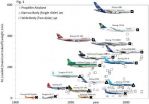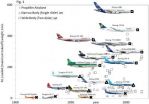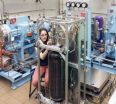(Press-News.org) WASHINGTON D.C., June 22, 2014 – Even within a phylum so full of mean little creatures, the yellow-colored Ormia ochracea fly is distinguished among other arthropods for its cruelty -- at least to crickets. Native to the southeastern U.S. states and Central America, the fly is a most predatory sort of parasite. It swoops onto the back of a singing male cricket, deposits a smear of larvae, and leaves its wicked brood to invade, kill and consume the cricket from inside out.
None of this would be possible without the fly's ability to find a cricket -- the cornerstone of its parasitic lifestyle. The fly can pinpoint the location of a chirping cricket with remarkable accuracy because of its freakishly acute hearing, which relies upon a sophisticated sound processing mechanism that really sets it apart from all other known insects.
Now a team of researchers at the University of Texas Austin has developed a tiny prototype device that mimics the parasitic fly's hearing mechanism, which may be useful for a new generation of hypersensitive hearing aids. Described in the journal Applied Physics Letters, from AIP Publishing, the 2-millimeter-wide device uses piezoelectric materials, which turn mechanical strain into electric signals. The use of these materials means that the device requires very little power.
"Synthesizing the special mechanism with piezoelectric readout is a big step forward towards commercialization of the technology," said Neal Hall, an assistant professor in the Cockrell School of Engineering at UT Austin. "Minimizing power consumption is always an important consideration in hearing-aid device technology.
There are military and defense applications as well, and Hall's work was funded by the Defense Advanced Research Projects Agency (DARPA). In dark environments, for instance, where visual cues are not available, localizing events using sound may be critical.
Super Evolved Hearing
Humans and other mammals have the ability to pinpoint sound sources because of the finite speed of sound combined with the separation between our ears. The spacing of several centimeters or more creates a slight difference in the time it takes sound waves to hit our ears, which the brain processes perceptually so that we can always experience our settings in surround sound.
Insects generally lack this ability because their bodies are so small that sound waves essentially hit both sides simultaneously. Many insects do detect sound vibrations, but they may rely instead on visual or chemical sensing to find their way through the fights, flights and forages of daily life.
O. ochracea is a notable exception. It can locate the direction of a cricket's chirp even though its ears are less than 2 mm apart -- a separation so slight that the time of arrival difference between its ears is only about four millionths of a second (0.000004 sec).
But the fly has evolved an unusual physiological mechanism to make the most of that tiny difference in time. What happens is in the four millionths of a second between when the sound goes in one ear and when it goes in the other, the sound phase shifts slightly. The fly's ear has a structure that resembles a tiny teeter-totter seesaw about 1.5 mm long.
Teeter-totters, by their very nature, vibrate such that opposing ends have 180-degree phase difference, so even very small phase differences in incident pressure waves force a mechanical motion that is 180 degrees out of phase with the other end. This effectively amplifies the four-millionths of a second time delay and allows the fly to locate its cricket prey with remarkable accuracy.
Such an ability is almost the equivalent of a human feeling an earthquake and being able to discern the direction of the epicenter by virtue of the difference in time between when the right and left foot first felt the tremor -- except the fly's hearing is even more sensitive than that, said Hall.
Mimicking the Mechanism
The pioneering work in discovering the fly's unusual hearing mechanism was done by Ronald Miles at Binghamton University and colleagues Ronald Hoy and Daniel Robert, who first described the phase amplification mechanism the fly uses to achieve its directional hearing some 20 years ago. In 2013, Miles, and his colleagues presented a microphone inspired by the fly's ears. (See related release: http://newswise.com/articles/researchers-design-sensitive-new-microphone-modeled-on-fly-ear)
Inspired by Miles's prior work, Hall and his graduate students Michael Kuntzman and Donghwan Kim built a miniature pressure-sensitive teeter-totter in silicon that has a flexible beam and integrated piezoelectric materials. The use of piezoelectric materials was their original innovation, and it allowed them to simultaneously measure the flexing and the rotation of the teeter-totter beam. Simultaneously measuring these two vibration modes allowed them to replicate the fly's special ability to detect sound direction in a device essentially the same size as the fly's physiology.
This technology may be a boon for many people in the future, since 2 percent of Americans wear hearing aids, but perhaps 10 percent of the population could benefit from wearing one, Hall said.
"Many believe that the major reason for this gap is patient dissatisfaction, he added. "Turning up the gain to hear someone across from you also amplifies all of the surrounding background noise – resembling the sound of a cocktail party."
The new technology could enable a generation of hearing aids that have intelligent microphones that adaptively focus only on those conversations or sounds that are of interest to the wearer. But before the devices become part of the next generation of hearing aids or smartphones, more design and testing is needed.
"The delicate mechanism must be protected from consumer handling with surrounding packaging," Hall said, "something the fly need not worry too much about."
INFORMATION:
The article, "Sound source localization inspired by the ears of the Ormia ochracea," is authored by Michael L. Kuntzman and Neal Hall. It will be published in the journal Applied Physics Letters on July 22, 2014. After that date, it can be accessed at: http://scitation.aip.org/content/aip/journal/apl/105/3/10.1063/1.4887370
ABOUT THE JOURNAL
Applied Physics Letters features concise, rapid reports on significant new findings in applied physics. The journal covers new experimental and theoretical research on applications of physics phenomena related to all branches of science, engineering, and modern technology. See: http://apl.aip.org
Fly-inspired sound detector
New device based on a fly's freakishly acute hearing may find applications in futuristic hearing aids and military technology
2014-07-22
ELSE PRESS RELEASES FROM THIS DATE:
Law of physics governs airplane evolution
2014-07-22
DURHAM, N.C. -- Researchers believe they now know why the supersonic trans-Atlantic Concorde aircraft went the way of the dodo -- it hit an evolutionary cul-de-sac.
In a new study, Adrian Bejan, professor of mechanical engineering and materials science at Duke University, shows that a law of physics he penned more than two decades ago helps explain the evolution of passenger airplanes from the small, propeller-driven DC-3s of yore to today's behemoth Boeing 787s. The analysis also provides insights into how aerospace companies can develop successful future designs.
The ...
The evolution of airplanes
2014-07-22
WASHINGTON D.C. July 22, 2014 -- One of the traditional arguments against Darwinian evolution has been that no one can confirm the process exists because it occurs on a time scale immensely greater than a human lifetime. Adrian Bejan, the J. A. Jones Distinguished Professor of Mechanical Engineering at Duke University, has disagreed with that notion ever since 1996 when he discovered the Constructal Law, a fundamental principle of physics that underlies the evolution of flow systems as they change in design over time.
In a new paper in the Journal of Applied Physics, ...
Bats use polarized light to navigate
2014-07-22
Scientists have discovered that greater mouse-eared bats use polarisation patterns in the sky to navigate – the first mammal that's known to do this.
The bats use the way the Sun's light is scattered in the atmosphere at sunset to calibrate their internal magnetic compass, which helps them to fly in the right direction, a study published in Nature Communications has shown.
Despite this breakthrough, researchers have no idea how they manage to detect polarised light.
'We know that other animals use polarisation patterns in the sky, and we have at least some idea ...
'Comb on a chip' powers new NIST/Caltech atomic clock design
2014-07-22
Researchers from the National Institute of Standards and Technology (NIST) and California Institute of Technology (Caltech) have demonstrated a new design for an atomic clock that is based on a chip-scale frequency comb, or a microcomb.
The microcomb clock, featured on the cover of the inaugural issue of the new journal Optica,* is the first demonstration of all-optical control of the microcomb, and its accurate conversion of optical frequencies to lower microwave frequencies. (Optical frequencies are too high to count;microwave frequencies can be counted with electronics.)
The ...
Mount Sinai scientists and international team shed new light on schizophrenia
2014-07-22
NEW YORK, NY -- As part of a multinational, collaborative effort, researchers from the Icahn School of Medicine at Mount Sinai have helped identify over 100 locations in the human genome associated with the risk of developing schizophrenia, in the largest genomic study published on any psychiatric disorder to date, conducted with 80,000 people. The findings, published online in Nature, point to biological mechanisms and pathways that may underlie schizophrenia, and could lead to new approaches to treating the disorder, which has seen little innovation in drug development ...
P90X? Why consumers choose high-effort products
2014-07-22
Stuck in traffic? On hold for what seems like an eternity? Consumers often face situations that undermine their feelings of control. According to a new study in the Journal of Consumer Research, when a person's sense of control is threatened, they are more likely to seek out products that require hard work.
"Intuitively, it would seem that feeling a loss of control might cause consumers to seek out a product that does NOT require them to exert very much effort. But we find that consumers actually look to products that require hard work to restore their belief that they ...
Fill 'er up: NIST develops prototype meter test for hydrogen refueling stations
2014-07-22
To support the fair sale of gaseous hydrogen as a vehicle fuel, researchers at the National Institute of Standards and Technology (NIST) have developed a prototype field test standard to test the accuracy of hydrogen fuel dispensers. Once the standard is field tested, it will serve as a model for constructing similar devices for state weights and measures inspectors to use.
Three automakers plan to begin selling hydrogen-fueled vehicles to consumers in 2015. The state of California has opened nine refueling stations and is funding the construction of an additional 28 ...
Overdoing it: Multiple perspectives confuse consumers
2014-07-22
Television commercials for luxury vehicles pack a lot in their 30-second running times: the camera offers quick shots of the soft leather upholstery, the shiny colors, the state-of-the-art entertainment system, and the four-wheel drive. But these multiple angles and shifting perspectives have a negative impact on consumer evaluation of products, according to a new study from a Tel Aviv University researcher.
TAU's Dr. Yael Steinhart and her collaborators Yuwei Jiang of Hong Kong Polytechnic University, Rashmi Adaval of Hong Kong University of Science and Technology, and ...
Why do challenging tasks make consumers believe drugs wear off faster?
2014-07-22
Imagine that you have a cup of coffee and sit down to read People magazine. How long do you think the energy boost will last before you reach for another cup? Would you need more caffeine if you tried to read War and Peace? A new study in the Journal of Consumer Research finds that consumers wrongly believe that pharmacological products such as coffee and aspirin lose their effectiveness when they engage in more strenuous activities.
"People make assumptions about how long it takes for products to wear off. For example, they know that cars burn gasoline more quickly ...
Empathy or justice: What makes consumers donate more to charity?
2014-07-22
Have you ever received a request for help and wondered how deserving the recipients are of your donation? This way of thinking may seem inconsistent with your moral values, especially if you consider yourself an otherwise compassionate and empathic person. A new study in the Journal of Consumer Research suggests that moral identity decreases donations when recipients are deemed to be responsible for their plight.
"Our research examines how moral values of empathy and justice have distinct influences on people when they are asked to make donations benefiting others whose ...
LAST 30 PRESS RELEASES:
ETRI develops an automated benchmark for labguage-based task planners
Revolutionizing memory technology: multiferroic nanodots for low-power magnetic storage
Researchers propose groundbreaking framework for future network systems
New favorite—smart electric wheel drive tractor: realizes efficient drive with ingenious structure and intelligent control
Using stem cell-derived heart muscle cells to advance heart regenerative therapy
Damon Runyon Cancer Research Foundation awards Quantitative Biology Fellowships to four cutting-edge scientists
Climb stairs to live longer
Scientists capture X-rays from upward positive lightning
AMS Science Preview: Hawaiian climates; chronic pain; lightning-caused wildfires
Researchers advance detection of gravitational waves to study collisions of neutron stars and black holes
Automated machine learning robot unlocks new potential for genetics research
University of Toronto scientists appointed as GSK chairs will advance drug delivery research and vaccine education tools for healthcare professionals
Air pollution and depression linked with heart disease deaths in middle-aged adults
More efficient molecular motor widens potential applications
Robotic nerve ‘cuffs’ could help treat a range of neurological conditions
Researchers identify targets in the brain to modulate heart rate and treat depressive disorders
Findings of large-scale study on 572 Asian families supports gene-directed management of BRCA1 and BRCA2 gene carriers in Singapore
Many children with symptoms of brain injuries and concussions are missing out on vital checks, national US study finds
Genetic hope in fight against devastating wheat disease
Mutualism, from biology to organic chemistry?
POSTECH Professor Yong-Young Noh resolves two decades of oxide semiconductor challenges, which Is published in prestigious journal Nature
Could fishponds help with Hawaiʻi’s food sustainability?
International network in Asia and Europe to uncover the mysteries of marine life
Anthropologist documents how women and shepherds historically reduced wildfire risk in Central Italy
Living at higher altitudes in India linked to increased risk of childhood stunting
Scientists discover a new signaling pathway and design a novel drug for liver fibrosis
High-precision blood glucose level prediction achieved by few-molecule reservoir computing
The importance of communicating to the public during a pandemic, and the personal risk it can lead to
Improving health communication to save lives during epidemics
Antimicrobial-resistant hospital infections remain at least 12% above pre-pandemic levels, major US study finds
[Press-News.org] Fly-inspired sound detectorNew device based on a fly's freakishly acute hearing may find applications in futuristic hearing aids and military technology




